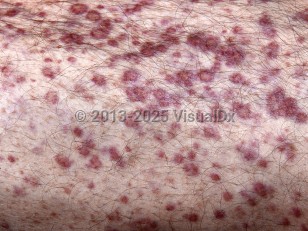MM is a disorder of adults (median age of diagnosis is late 60s) characterized by serum and/or urinary monoclonal proteins, hypercalcemia (38% of cases), anemia (about 80% of cases), painful lytic bone lesions (58%-70% of cases, often with fractures), decreased renal function with elevated creatinine (about 25%-48% of cases), and sometimes symptoms related to compression of the spinal cord (about 5% of cases). Rarely, corneal crystalline deposits may occur. Pediatric cases are extremely rare and may present more aggressively.
Infections, especially with encapsulated pyogenic organisms such as Haemophilus, Staphylococcus, and Streptococcus, are increased in patients with MM. Plasma cells are increased (10% or greater) in the bone marrow. Close monitoring and prophylactic measures, including vaccinations, are essential to manage infection risk effectively.
MM accounts for about 17% of hematologic malignancies in the United States and 1%-2% of all cancers. The disorder is twice as common in Africans and African Americans and is more common in males. Rare cases of myeloma have occurred after bone marrow transplant for leukemia.
Evaluation using serum and urine electrophoresis (SPEP and UPEP) reveals monoclonal protein in 97% of cases.
MM rarely presents with cutaneous involvement. Skin manifestations are typically apparent late in the disease course and are associated with reduced overall survival. Extramedullary plasmacytomas, although rare, are the most specific cutaneous finding. However, urticaria, amyloidosis, leukocytoclastic vasculitis, autoimmune bullous lesion formation, and pyoderma gangrenosum have been reported as the initial presentation of MM. These are sometimes related to the location of needle sticks and bone marrow aspirations.
Other skin findings in MM include:
- Follicular hyperkeratotic spicules, particularly on the face and nose, composed of monoclonal dysproteins.
- Cutaneous lesions associated with type 1 cryoglobulinemia.
- Primary amyloid accumulations in the skin.
- Schnitzler syndrome – A chronic urticarial eruption associated with bone pain and an M protein, either monoclonal gammopathy of undetermined significance (MGUS) or, rarely, myeloma.



